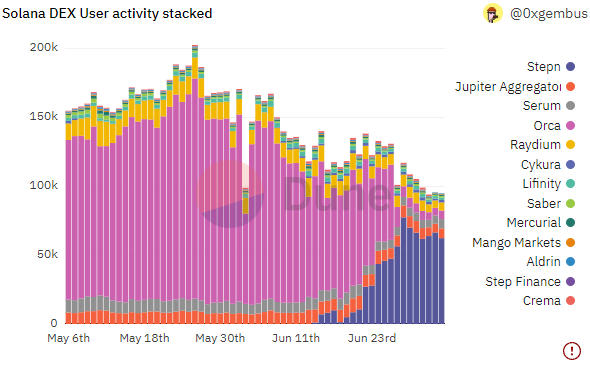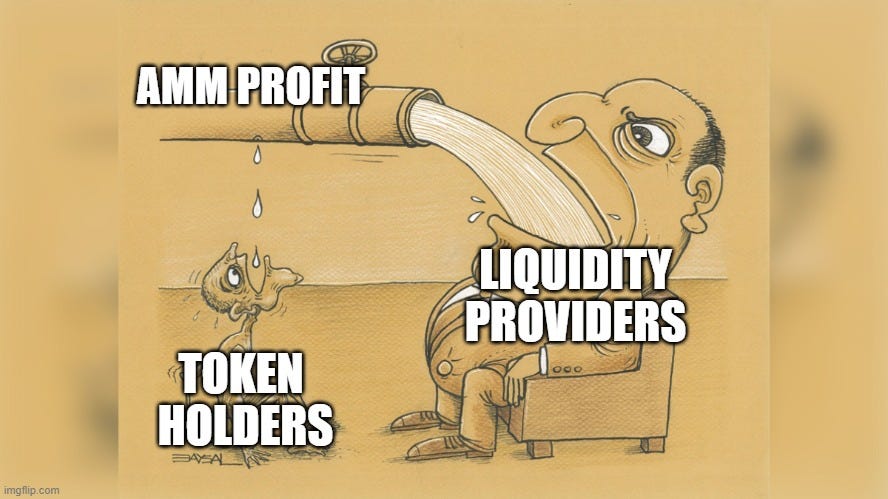pls fix: Automated Market Makers
Strategies for AMMs to achieve profitability.
Disclaimer, NFA, all that legal stuff: All the information presented on this publication and its affiliates is strictly for educational purposes only. It should not be construed or taken as financial, legal, investment, or any other form of advice.
Hi folks,
In this new weekly series, I aim to provide strategic recommendations for a protocol(s). The issue will either cover one specific protocol or a sector at a more granular level. Crypto is innovating at a lightning pace; and while I don’t claim to have all the answers, I believe that documenting these ideas in public is a good first step to instigating further discussions. I hope you’ll share it if you find it enjoyable.
-Marco
AMM Birthed DeFi
I remember how the original DeFi protocols, especially Uniswap, pioneered the boom that we now call the DeFi summer of 2020 (although Compound arguably started it) — anyway, the multi-year crypto bear market was swiftly ended with the help of Covid-19 lockdowns, Quantitative Easing, and the ability to create instant liquidity for any ERC-20 dog coin that you made as a side project.
Uniswap instigated an era of AMMs with numerous protocols launched on alternative L1 chains in the past two years. This is unsurprising given the fact that AMM is crucial for the DeFi ecosystem of said L1 chains, and “marketplace fees” being charged by exchanges, both centralized and decentralized, are one of the most tried and true business models in a financial market. Uniswap’s success made it clear that there is great upside to being the first/go-to AMM for an L1 chain.
While AMMs have managed to capture massive TVL and facilitate billions in trading volume, the large majority of AMMs are not making any real profits. In this write-up, we present a framework to think about the future AMMs, draw comparisons to existing models in TradFi, and provide strategies to achieve profitability.
Here are the quick takeaways:
Most (if not all) AMMs are not generating real profit.
Protocols should think about how they can accrue value back to token holders ASAP, especially those with less capital on their treasury reserves.
Protocols can ignore value accrual mechanics so long as their treasury is large enough but to the detriment of token holders.
Protocols can provide their own liquidity and generate real profits with a much smaller capital thanks to concentrated liquidity.
Vertically integrating with other DeFi products (wallets, play-to-earn, etc.) proved to be extremely beneficial for an AMM’s profitability.
Big Volume, Big TVL, Small Profit
Uniswap is consistently in the top 3 protocols in terms of fees generated. On some days, it even surpasses Ethereum’s, which is not too surprising given that it is the bedrock of DeFi market activities, with the total Users of Uniswap covering ~80% of DeFi users. It is also the only DEX that’s somewhat dominant enough to compete with CEXs. But despite all of that, it is not making any “real” profit.

How is Uniswap generating an average ~$7M fee weekly but has $0 revenue?
The answer is simple: all fees are given back to the Liquidity Providers (LPs), and almost every AMMs do that.
While VC funding might help an AMM bootstrap its ecosystem and acquire users, we still have not seen a clear path to profitability that will also guarantee the protocol’s defensibility. If we believe in bogus talking points to delay efforts in acquiring real revenues (and then sharing those revenues with token holders), this problem will eventually become akin to the ride-hailing industry’s inability to generate profit. At least until they realized that they can sell $40 tacos to the affluent upper-middle class to subsidize their ride-hailing losses — or overcharging prices from airports, but I digress.
@durdenwannabe wrote a great piece on this. When counting token emissions for liquidity mining rewards, the majority of AMMs are barely making profits.
Fee Switch or User Retention?
In the long run, AMMs should think about how they can start generating actual profit. Turning on the fee switch might be the easiest solution for most protocols. For Uniswap, this feature has yet to be activated. Below is how much Uniswap would’ve earned if they turned on the fee switch (assuming a 0.05% flat fee) since the beginning of 2022.

In Uniswap’s case, it makes sense that they had rather not risk turning on the fee switch given the size of its treasury, which is massive enough for multi-year runways. Also, the sec has knocked on their door. However, this means that the UNI token is practically a “useless governance token” and any value is predicated on the assumption that the fee switch will be turned on.
But hey, if the fee switch is on, analysts can make actual forecasts about UNI’s cash flow, anchoring its valuation to fundamental metrics that make sense. However, if there’s no anchor, the “potential” upside is endless. Sometimes, narratives make for a better investment case than fundamentals.
Let’s address several downsides of the fee switch:
Users, liquidity, and TVL go down - unhappy LPs will withdraw their liquidity because they receive fewer revenues. This can create second-order effects. TVL will drop, and users might go to other AMMs that provide cheaper swap fees or can provide a more capital-efficient trading experience.
Legal issue - AMMs that are based in the US will most likely have problems with the SEC. There is a reason why some teams are anonymous. The easiest solution for doxxed teams is frankly to relocate any entity associated with the protocol to a more crypto-friendly jurisdiction and block US access.

Unhealthy competition leads to collapse - Other AMMs, or even forks, can offer cheaper fees, making it a race to the bottom. Some protocols have built credibility and trust, but some tier B or tier C protocols might take advantage of the fee switch situation and implement unsustainable tokenomics to capture some market share.
Other Possible Revenue Streams
User retention is a crucial problem for every AMM. You do not want to lose your real users, market share, or liquidity — especially given the fact that mercenary capitals are everywhere. In the following section, we provide alternative methods for generating revenue streams for AMMs.
Disloyalty Fee
The disloyalty fee is charged to the LPs every time they withdraw capital before the expiry date. This fee can provide a more predictable recurring revenue for the protocols, akin to a subscriber-based business model that provides greater clarity on the financial health of the business, allowing analysts to create more accurate forecasts.
This fee is ideally allocated towards the primary pools (top 50, for example) which will most likely not suffer from the implementation. For successful AMMs, this is taking advantage of the brand and credibility that have been built throughout the years. LPs are sacrificing capital flexibility for battle-tested smart contracts and for receiving yields in the most active pool in DeFi.
Project Exclusivity or Vertical Integration
Orca was the largest DEX in Solana by daily active users until Stepn decided to stop using Orca and built its own AMM instead. This shows that entering into an exclusive partnership with a highly popular protocol such as Stepn (or Axie back then) can be key to winning more market share. Another method to do this is by vertically integrating multiple products under one ecosystem. Imagine if MetaMask or Phantom built its own AMM integrated within the wallet. This is even more feasible with concentrated liquidity.

Source: Dune
Protocol Owned + Concentrated Liquidity
With concentrated liquidity, AMMs require significantly less capital to facilitate larger trading volumes. By having a concentrated liquidity model and becoming its own LP, an AMM can get to profitability real quick.
Pros:
Capital Efficiency - LPs can customize the price range of their liquidity pool to generate more swap fees and prevent impermanent loss.
More Options - LPs can have custom price ranges to maximize their pool's efficiency.
Less Price Slippage - As the liquidity is concentrated, traders will experience less price slippage compared to a regular liquidity pool.
Cons:
Potentially a decrease in TVL - With concentrated liquidity, a big TVL is not as required since the LPs can customize their liquidity pools' price range.
Can’t do a large swap in one swoop - The pool is easily imbalanced if the swap volume is close to the amount of liquidity available for the price range.
Entertain me for a sec. Imagine if Phantom wallet built its own concentrated liquidity AMM, integrate it within the wallet, and become its sole dominant liquidity provider. Booyah!
Do You Want to Make Money?
TL;DR — most AMMs are not generating real profits. This trend, no matter what the arguments are, is not sustainable. Protocols should aim to get to real profitability ASAP, especially if they don’t have enough treasury for a multi-year bear market. The easiest way to achieve this is by turning on fees or by becoming the dominant LPs in your own protocols. The regulatory considerations to implement value accrual mechanics are tricky — but seemingly can be done (some protocols have done this) by relocating any entity (team members, foundations, etc.) associated with the protocols to a friendlier jurisdiction and decentralizing governance as much as possible.
Until next time,
Marco M.




